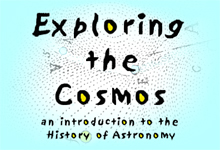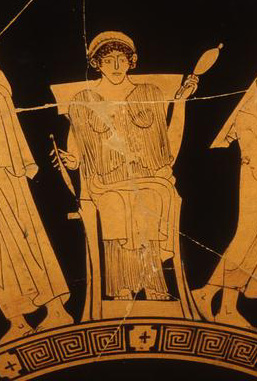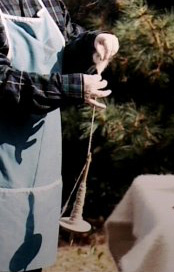

Department of History
University of California, Irvine
Instructor: Dr. Barbara J. Becker
![]()
Week 1. The Ancients.
"The Myth of Er"
from
The Republic
by Plato (428-348 BCE)
![]()
They came to a place where they could see from above a line of light, straight as a column, extending right through the whole heaven and through the earth, in color resembling the rainbow, only brighter and purer. Another day's journey brought them to the place, and there, in the midst of the light, they saw the ends of the chains of heaven let down from above: for this light is the belt of heaven, and holds together the circle of the universe, like the under-girders of a trireme. From these ends is extended the spindle of Necessity, on which all the revolutions turn. |
|
| Necessity was one of the names by which the Greek goddess, Themis,
was known. Themis bore Zeus three daughters: Clotho, Lachesis,
and Atropos, known as the Fates. These powerful women control the
past, present, and future of mortals and gods alike.
The youngest, Clotho, spins the thread of every life. Lachesis measures the thread and weaves its destiny. Atropos, usually portrayed as an old woman, cuts the thread.
This illustration (right) from a Greek bowl shows a woman spinning thread. She holds a distaff covered with a bundle of unspun fiber in her left hand and a spindle wrapped with spun thread in her right. |
 |
The shaft and hook of this spindle are made of steel, and the whorl is made partly of steel and also partly of other materials. |
|
 |
The photo (left) shows a woman spinning thread with a drop spindle. The spinner slowly pulls fibers from the wool in her left hand and
pinches it into a thread with her right hand. As she does this, she takes care to keep the spindle
and whorl below turning.
The whorl at the bottom of the spindle acts like a flywheel to keep it turning steadily. It also gives the spindle additional weight so the thread can be drawn with an even tension. |
The first and outermost whorl has the rim broadest, and the seven inner whorls are narrower, in the following proportions -- the sixth is next to the first in size, the fourth next to the sixth; then comes the eighth; the seventh is fifth, the fifth is sixth, the third is seventh, last and eighth comes the second. The largest [fixed stars] is spangled, and the seventh [or sun] is brightest; the eighth [or moon] colored by the reflected light of the seventh; the second and fifth [Saturn and Mercury] are in color like one another, and yellower than the preceding; the third [Jupiter] has the whitest light; the fourth [Mars] is reddish; the sixth [Venus] is in whiteness second. |
||||||||||||||||||||||||||||||
The spindle turns on the knees of Necessity; and on the upper surface of each circle is a siren, who goes round with them, humming a single tone or note. The eight together form one harmony; and round about, at equal intervals, there is another band, three in number, each sitting upon her throne: these are the Fates, daughters of Necessity, who are clothed in white robes and have garlands upon their heads, Lachesis and Clotho and Atropos, who accompany with their voices the harmony of the sirens -- Lachesis singing of the past, Clotho of the present, Atropos of the future; Clotho from time to time assisting with a touch of her right hand the revolution of the outer circle of the whorl or spindle, and Atropos with her left hand touching and guiding the inner ones, and Lachesis laying hold of either in turn, first with one hand and then with the other. |
||||||||||||||||||||||||||||||
|